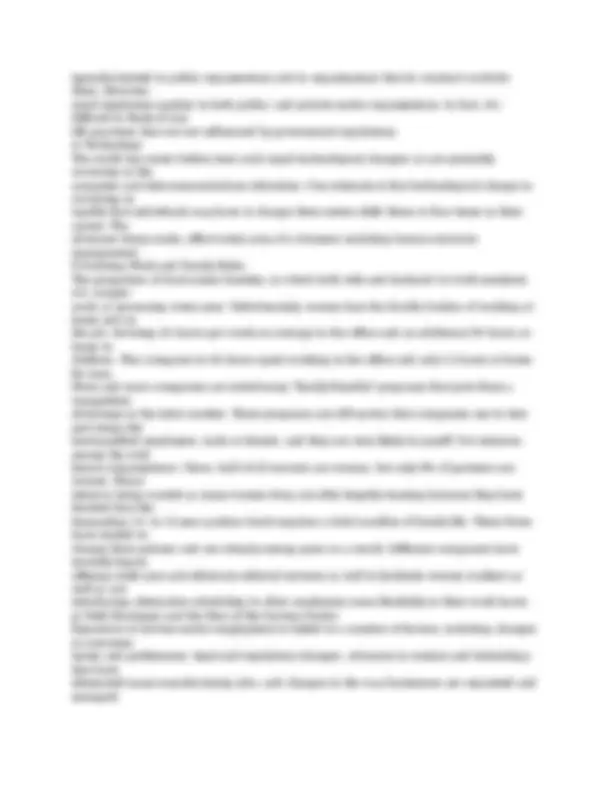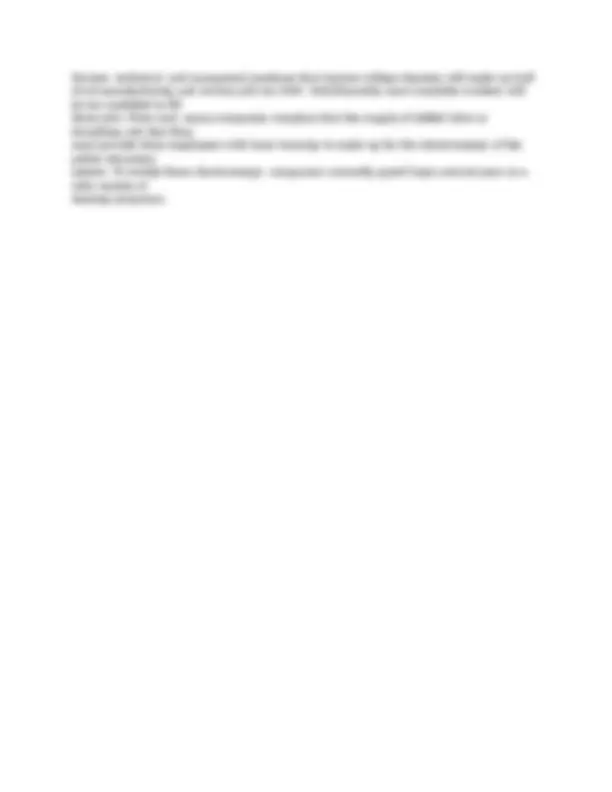




Study with the several resources on Docsity

Earn points by helping other students or get them with a premium plan


Prepare for your exams
Study with the several resources on Docsity

Earn points to download
Earn points by helping other students or get them with a premium plan
Community
Ask the community for help and clear up your study doubts
Discover the best universities in your country according to Docsity users
Free resources
Download our free guides on studying techniques, anxiety management strategies, and thesis advice from Docsity tutors
The challenges organizations face in today's rapidly changing business environment, focusing on six key environmental challenges: rapid change, workforce diversity, globalization, legislation, technology, and evolving work and family roles. How human resources (hr) policies can help firms adapt to these challenges, providing examples of successful hr strategies in areas such as workforce diversity, globalization, and legislation.
Typology: Study notes
1 / 4

This page cannot be seen from the preview
Don't miss anything!



HRM in a Changing Environment: The Challenges Today’s organizations are facing challenges upon following levels: i. Environmental Challenges ii. Organizational Challenges iii. Individual Challenges i. Environmental Challenges Environmental challenges refer to forces external to the firm that are largely beyond management’s control but influence organizational performance. They include: rapid change, the internet revolution, workforce diversity, globalization, legislation, evolving work and family roles, and skill shortages and the rise of the service sector. Six important environmental challenges today are: a) Rapid change, b) Work force diversity, c) Globalization, d) Legislation, e) Technology f) Evolving work and family roles, g) Skill shortages and the rise of the service sector a) Rapid Change Many organizations face a volatile environment in which change is nearly constant. If they are to survive and prosper, they need to adapt to change quickly and effectively. Human resources are almost always at the heart of an effective response system. Here are a few examples of how HR policies can help or hinder a firm grappling with external change: b) Work Force Diversity. All these trends present both a significant challenge and a real opportunity for managers. Firms that formulate and implement HR strategies that capitalize on employee diversity are more likely to survive and prosper. c) Globalization. One of the most dramatic challenges facing as they enter the twenty-first century is how to compete against foreign firms, both domestically and abroad. Many companies are already being compelled to think globally, something that doesn't come easily to firms long accustomed to doing business in a large and expanding domestic market with minimal foreign competition. Weak response to international competition may be resulting in upwards layoffs in every year. Human resources can play a critical role in a business's ability to compete head-to-head with foreign producers. The
implications of a global economy on human resource management are many. Here are a few examples: Worldwide company culture Some firms try to develop a global company identity to smooth over cultural differences between domestic employees and those in international operations. Minimizing these differences increases cooperation and can have a strong impact on the bottom line. For instance, the head of human resources at the European division of Colgate Palmolive notes, "We try to build a common corporate culture. We want them all to be Colgaters." Global alliances” Some firms actively engage in international alliances with foreign firms or acquire companies overseas to take advantage of global markets. Making such alliances work requires a highly trained and devoted staff. For instance, Phillips (a Netherlands lighting and electronics firm) became the largest lighting manufacturer in the world by establishing a joint venture with AT&T and making several key acquisitions. These illustrations show how firms can use HR strategies to gain a worldwide competitive advantage. d) Legislation Much of the growth in the HR function over the past three decades may be attributed to its crucial role in keeping the company out of trouble with the law. Most firms are deeply concerned with potential liability resulting from personnel decisions that may violate laws enacted by the state legislatures, and/or local governments. These laws are constantly interpreted in thousands of cases brought before government agencies, federal courts, state courts, and t Supreme Court. How successfully a firm manages its human resources depends to a large extent on its ability to deal effectively with government regulations. Operating within the legal framework requires keeping track of the external legal environment and developing internal systems (for example, supervisory training and grievance procedures) to ensure compliance and minimize complaints. Many firms are now developing formal policies on sexual harassment and establishing internal administrative channels to deal with alleged incidents before employees feel the need to file a lawsuit. Legislation often has a differential impact on public- and private sector organizations. (Public sector is another term for governmental agencies; private sector refers to all other types of organizations.) Some legislation applies only to public-sector organizations. For instance, affirmative action requirements are
Service, technical, and managerial positions that require college degrees will make up half of all manufacturing and service jobs by 2000. Unfortunately, most available workers will be too unskilled to fill those jobs. Even now, many companies complain that the supply of skilled labor is dwindling and that they must provide their employees with basic training to make up for the shortcomings of the public education system. To rectify these shortcomings, companies currently spend large amount year on a wide variety of training programs.